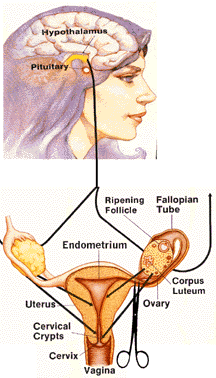|
|
|
| FACTS | MODE OF ACTION |
Plastic device placed in
uterus through the cervical canal; may contain trace metals or hormones to
increase contraceptive efficacy
Only about 84 percent effective (Alan Guttmacher Institute) Cost of IUD insertion and yearly medical fees can total more than $350 per year
|
Still not completely understood how IUD prevents pregnancy, but seems to create chronic inflammation of the endometrium, which prevents implantation of newly conceived human life; hence abortifacient |
|
POTENTIAL SIDE EFFECTS |
|
| Occasional
perforation of uterus or cervix requiring surgery
Increased risk of miscarriage (spontaneous abortion) Ectopic (extrauterine) pregnancies 10 times above usual incidence in women Pelvic inflammations that can cause sterility Anemia due to excessive menstrual bleeding Embedding, migration of fragmentation of IUD Spotting or prolongation of menstrual flow Presence of actinomyces in pap smears of 90 percent of users; infection of reproductive organs by actinomyces rare, but is typically found in long-term IUD users Increased risk of HIV infection |
|

 Contrary to claims that condoms can be an effective means of preventing
the spread of AIDS, the fact is that the human immunodeficiency virus is
450 times smaller than a human sperm - obviously, since condoms fail
anywhere from 12 to 44 percent of the time in preventing pregnancy, they
are even less effective in preventing the transmission of this tiny virus!
Contrary to claims that condoms can be an effective means of preventing
the spread of AIDS, the fact is that the human immunodeficiency virus is
450 times smaller than a human sperm - obviously, since condoms fail
anywhere from 12 to 44 percent of the time in preventing pregnancy, they
are even less effective in preventing the transmission of this tiny virus!

 (tubes
through which sperm travel from the testes to the prostate) and ties off
ends
(tubes
through which sperm travel from the testes to the prostate) and ties off
ends
 More or less irreversible technique for
preventing conception
More or less irreversible technique for
preventing conception